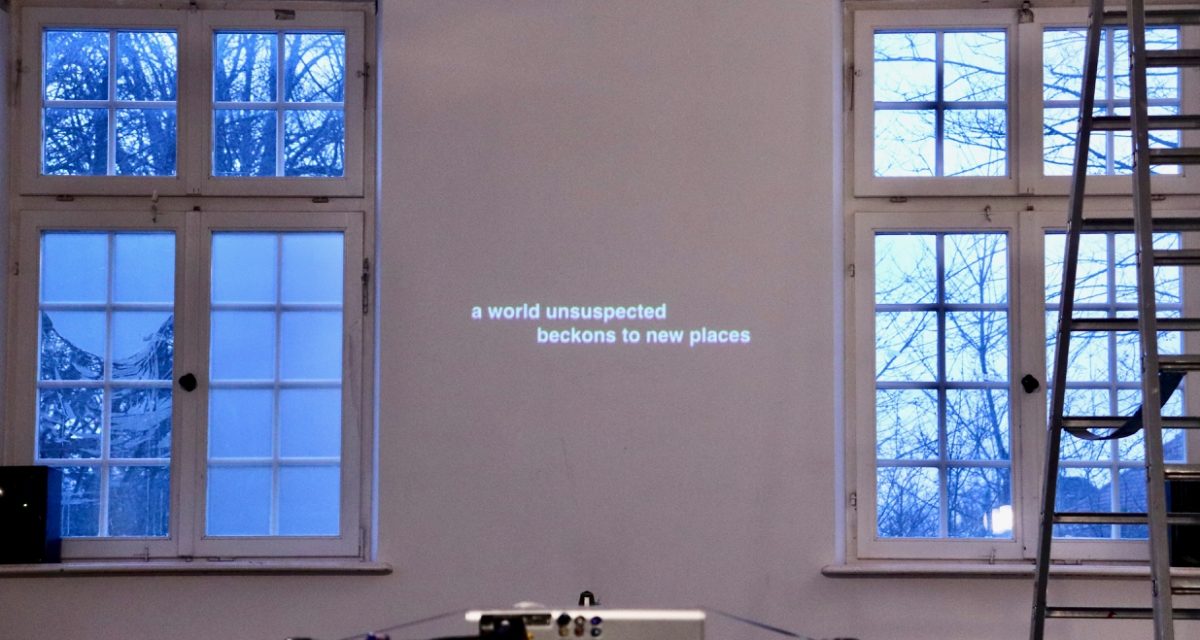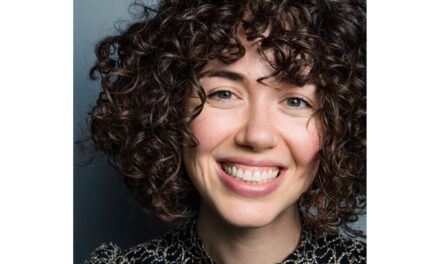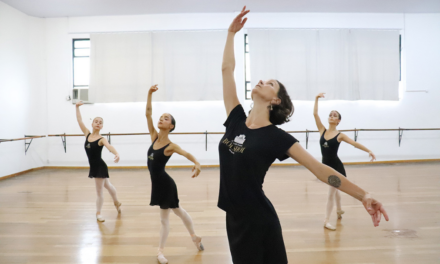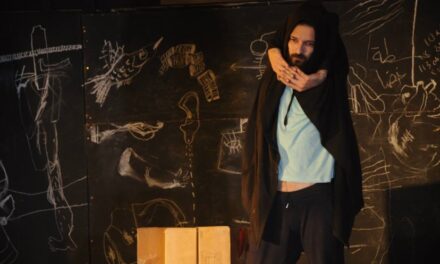Each day at 6 pm, performers Till Wyler von Ballmoos and Cássio Diniz Santiago opened the doors to their rehearsal studio for exactly ten minutes. Over nine days (except on Sunday), visitors were invited to attend an ongoing process. Every day a minute was added to the dramaturgy of the performance; the so-called Openings. The performance on the ninth day was an accumulation of one-minute performances. Except, what one would not notice, each day the doors were already open ten minutes before 6 pm.
The play had already started when the audience was on the way to join the stage. Testing pre-conducted conditions, the work forced the audience to reflect on given parameters and various measurement systems, i.e. time, rhythm, cartography, geometry, but especially the semiotics of (body) language, memory, and made-up realities. Denise Helene Sumi in conversation with the two performers.
Denise Helene Sumi (DS): What happens if one layer of reality points in the opposite direction to the other, although it seems that the function of their display relays on the same system? To enter any sort of temporal shift or unusual condition requires the ability to let go of well-known, one could also say well-learned and archived agreements on how we perceive reality. On the one hand, we use structuring elements to understand and explain a shared reality, like measuring indicators. On the other, we structure time: a metronome ticks off a certain given rhythm; a global map should show us the world; or our regular heartbeat structures our blood circulation. While these tools function as an equalization to represent shared values and general applicable measurement systems, they also simply make things work. They are only tools that can turn upside-down under special conditions and circumstances. Sometimes, as in the case of most world maps, these tools are already a distortion of reality itself. What happens when the heart beats more quickly than usual? What happens when people faint? When we are not prepared for these shifts, we are often anxious and stressed, in some cases curious.
Cássio Diniz Santiago (CDS): Thousands of realities are happening in a single moment. Sometimes we are tuned into just one layer of reality. The overlapping of different realities – which concretely appears in this particular performance in the form of different materials from different origins – is a way to bring up the perception of the coexistence of these different realities. Every so-called reality is contained in the other realities, and every reading or interpretation we can make of them is always partial, that is, a cut that freezes the movement of experience.
The spectators’ entrance causes this dynamic of potentialities to be reestablished because each one that enters the performance room is in a different reality. Therefore the dialogue of each spectator with the performance happens in a singular way and at the same time shared, because they are looking at the same elements, but having different perceptions. In the end, a collage of perceptions produces a common reality to everyone in the room.

Lift And Carry by Till Wyler von Ballmoos and Cássio Diniz, 2018 | Photo Credit: Dina Karadžić
“Everything occurs in the time of the experience in conflict with the time of the clock. The performance slips over time, scores, and itineraries.”– Cássio Diniz Santiago
Till Wyler von Ballmoos (TWB): Our work started as a formal experiment on the emergence of an idea and the search for the birth and death of creation, respectively. The performative inquiry was meant to be a preliminary study for a common work about rituals in modern capitalism, obtainment, and preservation. After one week of so-called “openings,” the work became more and more a reflection about time, duration, rhythm, cyclic processes, and transcendence. The serial conception of the performance invited the audience to experience the ongoing development of the piece step by step. This strategy of staging facilitated an exchange about the thematic fields and diverse forms of the openings within a growing community of visitors as a result of the cyclic “reopenings.”
DS: Entering the studio for the second time this week; this has already become a ritual. We gather in the same but different space. The framework of the ongoing performance Lift and Carry has not changed yet. After one minute the video image on the wall, which showed a metronome, disappears, with it the “real” measuring tool. Also the wooden cuboid, upon which the real metronome was positioned, falls and from now on lies quirkily in the room. Instead of this simple given geometrical form, complex language appears:
“The descent beckons
as the ascent beckoned
The descent
made of despairs
realizes a new awakening
which is reversal
of despair” [1]
Each second is a descent into memory, a descent into our own inner depths. Nothing is made entirely of one direction, not even a crisis. On stage, the ascent is now symbolized by a ladder. Climbing up this “holy” ladder changes the perspective. High above the ground, that’s where mythology evolved. A whole colorful stage in the shape of daily changing Indian pigments unfolds on the ground. We are walking this world stage, but this world itself seems unreal. “There is the world that was created by the divine contractions of our lungs.” In fact it is a plastic globe. An offstage voice explains the props, stripping off context to reveal a multilayered perspective on “the world outside ourselves, and the world in our own minds.”
“The ladder exists only inside your dreams, that sometimes are gathered in here, inside this machine.” [2]
TWB: Referring to the biblical story of Jacob’s Dream, the motif of the folded ladder was a straightforward translation, a metaphor for ascent and descent. Beyond the possibility to shift perspectives by climbing above the level of the ground, shared with the audiences, our main interest was in the top point of this object, consisting of the two ladders. The tip of the ladder represents, in a metaphorical perspective, a culminating position in the horizon of events. It also pictures the tipping point in moments of crisis, where the decision to descent or ascent is suspended for a split of a second in an otherwise binary conceptualized system. We have been looking for such moments in the course of development.
CDS: For me, the ladder represents different worlds, each step a different world, that is, not a different reality, but a different perception of reality. Each mode of perception is also contained in other modes of perception, and all form a numerical set manifested by the steps of the ladder. It is possible to climb or descend, but it is also possible to jump from the first step to the last step and vice versa. Each step has a gate for all the other steps, or rather, each step contains all the others. This, in my view, is the most important, because we know that we are not trapped in one world, but we can always follow to each other and load the learning provided by each step.

Ephraim Moses Lilien, The Creation Of Man, 1903 | Photo Credit: Schloss – Post
DS: Meanwhile the genesis of MANkind gradually becomes apparent during an extensive performance, and with it also its circular ruins. The performance Lift and Carry creates an expanded field of conflicted relations and movements oscillating between starting point and ending point, birth and death. Staging an overlayering of references (i.a. the poem The Descent by William Carlos Williams, The Circular Ruins by Jorge Luis Borges, Ich hab im Traum geweinet by Heinrich Heine, The Four Worlds of Kabbalah) and crossing experiences, the performance also asks: What is it like to be alive? What is it like to feel our senses? What is it like to die?
CDS: The death event is what makes all events happen. Where there is no death, nothing happens, as in Borges’ tale. At the same time, we can’t witness our own death, and we can only get an idea about death through a near-death experience, in a way our death does not happen to us, but to others who witness. In performance there is something like that, because in a certain way, art only happens in the eyes of the beholder, performance only happens within the spectators, and it is they who will bring the answer to what we are doing.
TWB: The eclectic composition consisting of sound elements, music pieces, images, and quotes from diverse literal sources as well as a newly invented choreography of bodies was the foundation of our concept. Our idea was to deconstruct gridlocked semiotics and to create a series of conflicts, which are tied to the origin of the various media. But it was also a playful experiment on the process of devising a performance by layering and juxtaposing well-known masterpieces. And we were always curious to find out how long the next minute would last.
DS: At the end, when the metronome starts measuring the rhythm of one minute again, it seems that only time itself exists. In contrast to this “temporal prison,” the accumulation of various unstable signs (of life and death, of our feelings and senses, etc.) obtains a final shape. The shape of letting go and left off, getting carried away.
NOTES:
- Collage of the poem The Descent by William Carlos Williams, first published in 1948.
- The machine is a projector.
This article was originally published on Schloss – Post. Reposted with permission. Read the original article.
This post was written by the author in their personal capacity.The opinions expressed in this article are the author’s own and do not reflect the view of The Theatre Times, their staff or collaborators.
This post was written by Cássio Diniz Santiago and Till Wyler von Ballmoos.
The views expressed here belong to the author and do not necessarily reflect our views and opinions.


















